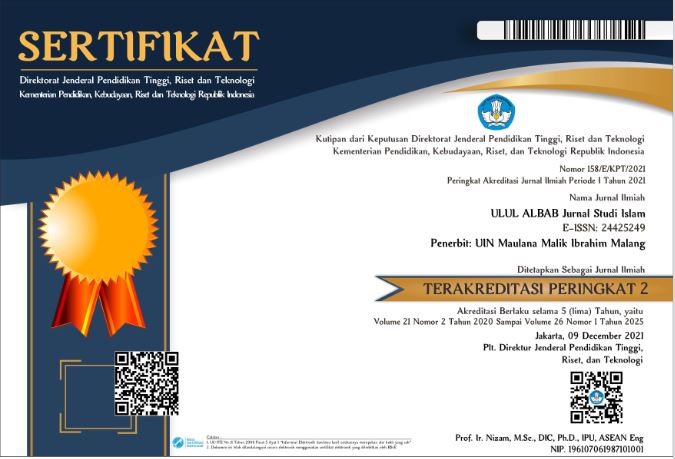PERFORMANCE MEASUREMENT OF PUBLIC SERVICE AGENCY IN HIGHER EDUCATION INSTITUTIONS: A Balanced-Scorecard Model Approach
Abstract
This study aims to develop a framework for measuring higher education performance as the Public Service Agency. The authors adapted one of the measurement models, namely the Balance Score Card Model. This is a qualitative study with library research type. The data collection uses literature documents related to the discussion subject. The results show that the Balanced Scorecard Model could be used to measure the performance of higher education institutions that has the mandate as the Public Service Agency. The target of the Balanced Scorecard Model is developed to measure the corporation. Corporations and public institutions have different objectives, characteristics, and philosophies. However, the model can be utilized to measure the performance of public institutions by adapting the components from each perspective. This study contributes to the development of higher education performance measurement framework serving as the Public Service Agency.
Keywords
Full Text:
PDFReferences
Ahmad, Abd Rahman, and Ng Kim Soon. 2015. “Balanced Scorecard in Higher Education Institutions: What Should Be Consider?” 2nd International Symposium on Technology Management and Emerging Technologies, ISTMET 2015 - Proceeding: 64–68.
al-Hosaini, Fahmi Fadhl, and Saudah Sofian. 2015. “A Review of Balanced Scorecard Framework in Higher Education Institution (HEIs).” International Review of Management and Marketing 5(1): 26–35.
Allison, Michael, and Jude Kaye. 2005. Perencanaan Strategis (Bagi Organisasi Nirlaba). Jakarta: yayasan Obor Indonesia.
Brown, Cindy. 2012. “Application of the Balanced Scorecard in Higher Education: Opportunities and Challenges: An Evaluation of Balance Scorecard Implementation at the College of St. Scholastica.” Planning for Higher Education 40(4): 40.
Bryson, John M. 1995. Strategic Planning for Public and Nonprofit Organization. San Franciscon: Jossey-Bass.
Cortese, Anthony D. 2003. “The Critical Role of Higher Education in Creating a Sustainable Future.” Planning for Higher Education: 3(3):15-22.
David, Fred R. 2011. Strategic Management (Concepts and Cases). 13th ed. ed. Sally Yagan. New Jersey: Prentice Hall.
Dit. PPK BLU. 2020. Guideline Book – BLU Maturity Rating Assessment Tools and Evaluation. Jakarta: Kementerian Keuangan.
Government Regulation of the Republic of Indonesia No. 74 of 2012 on the Amendments to the Government Regulation No. 23 of 2005 concerning Financial Management of Public Service Agencies. 2012. Indonesia.
Government Regulation of the Republic of Indonesia No. 23 of 2005 concerning Financial Management of Public Service Agencies. 2005. Indonesia.
Government Regulation of the Republic of Indonesia No. 4 of 2014 concerning the Implementation of Higher Education and Management of Higher Education. 2014. Indonesia.
Hadi, Sutrisno. 2004. Metodologi Research 2. Yogyakarta: Andi Offset.
Hammer, M., and J. Champy. 1993. Re-Engineering the Corporation: A Manifesto for Business Revolution. New York: Harper Business.
Indrajit, Eko, R., and R. Djokopranoto. 2006. Manajemen Perguruan Tinggi Modern. Yogyakarta: Andi Offset.
Kaniški, Ivica, and Ivan Vincek. 2018. “Business Processes as Business Systems.” Tehnički glasnik 12(1): 55–61.
Kaplan, R. S., and D. P. Norton. 2004. Strategy Maps: Converting Intangible Assets into Tangible Outcomes. Boston Massachusetts: Harvard Business School Press.
Kaplan, R. S., and David Norton. 1996. Harvard Business School Press The Balance ScoreCard (Menerapkan Strategi Menjadi Aksi). eds. Yati Sumiharti and Wisnu Chandra Kristiaji. Jakarta: PT. Gelora Aksara Pratama.
Kaplan, R. S, and David P Norton. 2001. “Transforming the Balanced Scorecard from Performance Measurement to Strategic Management: Part I.” Accounting Horizons 15(1): 87–104. DOI: https://doi.org/10.2308/acch.2001.15.1.87.
KBBI. 2016. “Indonesia Dictionary.” https://kbbi.kemdikbud.go.id/.
Lassoued, Kaïs. 2018. “Balanced Scorecard Implementation in Higher Education: An Emirati Perspective.” Corporate Ownership and Control 15(3–1): 205–16. DOI:10.22495/cocv15i3c1p5.
Law of the Republic of Indonesia No. 12 of 2012 on Higher Education. 2012. Indonesia.
Mahmudi. 2013. Manajemen Kinerja Sektor Publik. Yogyakarta: UPP STIM YKPN.
Mangkunegara, A.P. 2013. Manajemen Sumber Daya Manusia Perusahaan. Bandung: PT. Remaja Rosdakarya.
Ministry of Research, Technology and Higher Education. 2019. “Indikator Kinerja Utama Perguruan Tinggi Negeri Dan Lembaga Layanan Pendidikan Tinggi Di Lingkungan Kementerian Riset, Teknologi, Dan Pendidikan Tinggi Tahun 2019.”
http://link.utu.ac.id/kepmenristekdikti-nomor-142mkpt2019-ttg-iku-ptn-2019.
Moeheriono. 2012. Indikator Kinerja Utama (IKU). Jakarta: Rajawali Press.
Nawawi, H. 2006. Evaluasi Dan Manajemen Kinerja Di Lingkungan Perusahaan Dan Industri. Yogyakarta: Gadjah Mada University Press.
Niven, P.R. 2011. Balanced Scorecard: Step-by-Step for Government and Nonprofit Agencies. Willey.
Park, Jeong Ah, and Gary B Gagnon. 2006. “A Causal Relationship Between the Balanced Scorecard Perspectives.” Journal of Human Resources in Hospitality & Tourism 5(2): 91–116. DOI: https://doi.org/10.1300/J171v05n02_06.
Patro, A. 2016. “Using Balance Scorecard in Educational Institutions.” International Journal of Business and Management Invention 5(11): 70–77.
Porter, E. M. 1985. Competitive Advantage-Creating and Sustaining Superior Performance. New York: Free Press.
Regulation of the Minister of Finance the Republic of Indonesia No. 129/Pmk.05/2020 concerning the Guidelines of Public Services Agency Management. 2020. Indonesia.
Religa, Arlyz Savan. 2022. “Apa Itu Perusahaan Nirlaba? Simak Pengertiannya Disini.” Investree. https://blog.investree.id/bisnis/apa-itu-perusahaan-nirlaba-simak-pengertiannya-disini/#:
Ronchetti, Jan L. 2006. “An Integrated Balanced Scorecard Strategic Planning Model for Nonprofit Organizations.” Journal of Practical Consulting 1(1): 25–35.
Sekaran, Uma. 2003. Research Methods for Business (A Skill Building Approach). 4th ed. United Stated of American: John Wiley & Sons.
Sekaran, Uma, and Roger Bougie. 2016. Research Methods for Business (A Skill Building Approach). 7th ed. United Kingdom: John Wiley & Sons.
Sutarso, Yudi. 2007. “Marketing Public Relation Perguruan Tinggi.” YudiSutarso (kuliah manajemen pemasaran).
https://ysutarso.wordpress.com/2007/06/18/marketing-public-relation-perguruan-tinggi/ (May 1, 2020).
Tampubolon, P D. 2001. Perguruan Tinggi Bermutu (Paradigma Baru Manajemen Pendidikan Tinggi Menghadapi Tantangan Abad Ke-21). Jakarta: PT. Gramedia Pustaka Utama.
Thompson, A. J., and A. J. Strickland. 1998. Strategic Management, Concepts and Cases. Irwin USA: Mc. Graw Hill Company.
Wahid, F. 2004. Teknologi Informasi Di Perguruan Tinggi Peluang Dan Tantangan. Yogyakarta.
Wibowo. 2013. Manajemen. Jakarta: Rajawali Press.
DOI: https://doi.org/10.18860/ua.v23i1.15559
Refbacks
- There are currently no refbacks.
Tools:




Indexed By:








All publication by Ulul Albab: Jurnal Studi Islam are licensed under a Creative Commons Attribution-ShareAlike (CC BY-SA)
Ulul Albab: Jurnal Studi Islam, P-ISSN : 1858-4349, E-ISSN : 2442-5249



